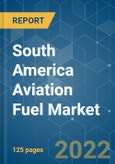The South American aviation fuel market is expected to value at USD 17.71 billion in 2027, up from USD 5.20 billion in 2020, registering a CAGR of 18.57% during the forecast period of 2022-2027. The COVID-19 pandemic has negatively impacted the South American aviation fuel market, leading to lockdowns globally (including South America) combined with restricted national and international travel, severely hitting the aviation industry in 2020. However, the market has shown signs of recovery. It is expected to revive pre-COVID-19 levels by the end of 2022, with the widespread availability of a vaccine. The recovering number of air passengers, on account of the cheaper airfare in recent times, stronger economic conditions, and increasing disposable income are among the major driving factors for the market. Moreover, the market can face hurdles in the coming years due to the high share of fossil-fuel-based aviation fuels in South American countries, which are responsible for the degradation of the environment.
The South American aviation fuel market is moderately fragmented. Some of the major companies include Petroleo Brasileiro SA, BP PLC, Shell PLC, TotalEnergies SE, and Repsol SA.
This product will be delivered within 2 business days.
Key Highlights
- With increasing connectivity and decreasing airfares, the commercial sector is expected to witness significant growth in the aviation fuel market during the forecast period.
- South America is one of the leading regions in biofuels. With an increasing shift towards aviation biofuels, significant opportunities are likely to be created in the near future.
- Brazil is the largest consumer of aviation fuels in South America, resulting in its dominance in the region. With the growing market, the nation is expected to continue its dominance during the forecast period also.
Key Market Trends
The Commercial Sector to Witness a Significant Growth
- Commercial aviation includes operating scheduled and non-scheduled aircraft, which involves commercial air transportation of passengers or cargo. The commercial segment is one of the largest consumers of aviation fuel, and it accounts for a quarter of the total operating expenditure for an airline operator.
- The total number of passengers transported in Latin America was 21.73 million in 2020 (IATA), registering a decline of 72% compared to 2019.
- The privatization of airports in countries, such as Brazil, Jamaica, Honduras, Paraguay, and Peru, is expected to develop the airport infrastructure and enhance capacity, thereby supporting the market studied in the region.
- On the other hand, the short-haul flights in the region have been increasing their share of the air traffic. In Latin America, the low-cost (LCC) and ultra-low-cost (ULCC) movements are in full swing. At present, more than ever, low-cost carriers in the region seem to be taking off faster than legacy airlines.
- Moreover, in April 2021, LanzaJet, one of the most promising aviation biofuel startups globally, announced that Shell had joined as an investor in the company to advance global growth, accelerate the commercialization of its technology, and scale the production of Sustainable Aviation Fuel (SAF). As a part of its Brazilian joint venture Raizen, Shell has already been producing bioethanol for over ten years, and the company has demonstrated the production of cellulosic ethanol from waste materials.
- Owing to the above points, the commercial sector is expected to witness significant growth in the South American aviation fuel market during the forecast period.
Brazil to Dominate the Market
- Brazil is the largest consumer of aviation fuels in South America. The products specified for use in aircraft in the country are aviation kerosene (QAV), aviation gasoline, and alternative aviation kerosene (alternative QAV).
- The sales of aviation fuels remained stable in the past years, except in 2020, wherein the sales for aviation kerosene and aviation gasoline dropped from 6.98 billion m3 and 43 million m3 in 2019 to 3.46 billion m3 and 38 million m3 in 2020.
- However, with the ease of travel restrictions, the aviation industry in the country is expected to rebounding. As of August 2021, the carriers operating in the country had recovered 44% of their pre-pandemic traffic, as reported by the National Civil Aviation Agency (ANAC).
- Another factor that affected the sales of aviation fuel in-country was Petrobras’ supply stoppage of imported aviation due to the results of the chemical tests that ran on an imported batch which raised the potential issue. This also caused significant fuel distributors BR Distribuidora and Raizen to suspend the sale of the product.
- In October 2020, the Brazilian federal government launched the Voo Simples program, which will bring a set of 50 measures for the general aviation industry, especially for professionals, aircraft operators, educational institutions, and small businesses.
- Overall, the aviation fuel market for Brazil is expected to register a decent growth during the forecast period, owing to the supporting government initiatives, which are likely to aid the market's growth further.
Competitive Landscape
The South American aviation fuel market is moderately fragmented. Some of the major companies include Petroleo Brasileiro SA, BP PLC, Shell PLC, TotalEnergies SE, and Repsol SA.
Additional Benefits:
- The market estimate (ME) sheet in Excel format
- 3 months of analyst support
This product will be delivered within 2 business days.
Table of Contents
1 INTRODUCTION
4 MARKET OVERVIEW
5 MARKET SEGMENTATION
6 COMPETITIVE LANDSCAPE
Companies Mentioned (Partial List)
A selection of companies mentioned in this report includes, but is not limited to:
- Petroleo Brasileiro SA
- Repsol SA
- BP PLC
- Shell PLC
- TotalEnergies SE
- Pan American Energy SL
- Exxon Mobil Corporation
- Allied Aviation Services Inc.
Methodology

LOADING...








